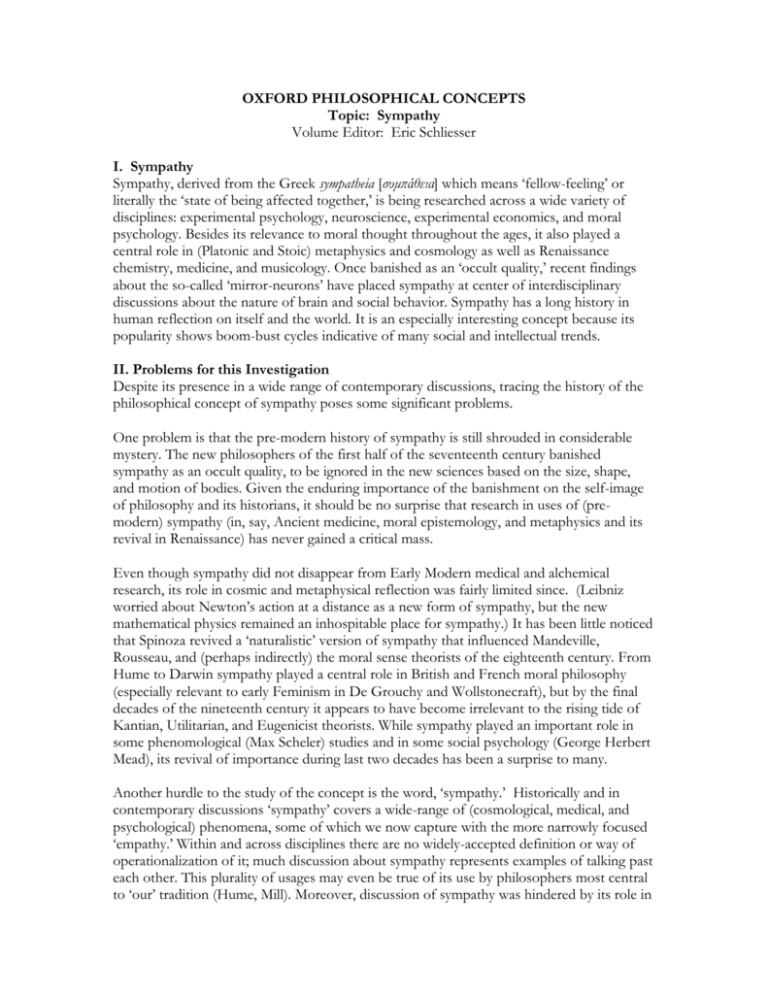One hurdle that we face in investigating the history of the
advertisement

OXFORD PHILOSOPHICAL CONCEPTS Topic: Sympathy Volume Editor: Eric Schliesser I. Sympathy Sympathy, derived from the Greek sympatheia [συμπάθεια] which means ‘fellow-feeling’ or literally the ‘state of being affected together,’ is being researched across a wide variety of disciplines: experimental psychology, neuroscience, experimental economics, and moral psychology. Besides its relevance to moral thought throughout the ages, it also played a central role in (Platonic and Stoic) metaphysics and cosmology as well as Renaissance chemistry, medicine, and musicology. Once banished as an ‘occult quality,’ recent findings about the so-called ‘mirror-neurons’ have placed sympathy at center of interdisciplinary discussions about the nature of brain and social behavior. Sympathy has a long history in human reflection on itself and the world. It is an especially interesting concept because its popularity shows boom-bust cycles indicative of many social and intellectual trends. II. Problems for this Investigation Despite its presence in a wide range of contemporary discussions, tracing the history of the philosophical concept of sympathy poses some significant problems. One problem is that the pre-modern history of sympathy is still shrouded in considerable mystery. The new philosophers of the first half of the seventeenth century banished sympathy as an occult quality, to be ignored in the new sciences based on the size, shape, and motion of bodies. Given the enduring importance of the banishment on the self-image of philosophy and its historians, it should be no surprise that research in uses of (premodern) sympathy (in, say, Ancient medicine, moral epistemology, and metaphysics and its revival in Renaissance) has never gained a critical mass. Even though sympathy did not disappear from Early Modern medical and alchemical research, its role in cosmic and metaphysical reflection was fairly limited since. (Leibniz worried about Newton’s action at a distance as a new form of sympathy, but the new mathematical physics remained an inhospitable place for sympathy.) It has been little noticed that Spinoza revived a ‘naturalistic’ version of sympathy that influenced Mandeville, Rousseau, and (perhaps indirectly) the moral sense theorists of the eighteenth century. From Hume to Darwin sympathy played a central role in British and French moral philosophy (especially relevant to early Feminism in De Grouchy and Wollstonecraft), but by the final decades of the nineteenth century it appears to have become irrelevant to the rising tide of Kantian, Utilitarian, and Eugenicist theorists. While sympathy played an important role in some phenomological (Max Scheler) studies and in some social psychology (George Herbert Mead), its revival of importance during last two decades has been a surprise to many. Another hurdle to the study of the concept is the word, ‘sympathy.’ Historically and in contemporary discussions ‘sympathy’ covers a wide-range of (cosmological, medical, and psychological) phenomena, some of which we now capture with the more narrowly focused ‘empathy.’ Within and across disciplines there are no widely-accepted definition or way of operationalization of it; much discussion about sympathy represents examples of talking past each other. This plurality of usages may even be true of its use by philosophers most central to ‘our’ tradition (Hume, Mill). Moreover, discussion of sympathy was hindered by its role in the reception of Adam Smith’s views; nineteenth century German scholars tended to view ‘sympathy’ as a synonym for benevolence, thus, giving rise to notorious ‘Das Adam Smith problem.’ III. Contemporary Discussions of Sympathy A: Mirror Neurons. One central area of ongoing research and discussion in cognitive sciences is the interpretation of an ongoing empirical findings that center on the discovery in animals and humans of systems of neurons that ‘encode’ and ‘re-present’ the (imagined) goal-directed movements of others and self. Moreover, the interaction of these systems with semantic and affective systems is said to provide a clue to the neuronal basis of all kinds of important social mechanism, theory of minds, and moral behavior. An important new line of research is the importance of mechanism that govern self-regulation of sympathy. B: Sympathy in Economics. Experimental economists have developed laboratory ‘games’ that are meant uncover the development of trust and social behavior in exchange relationships. This has produced stable results that show that under certain ‘institutions’ and regimes people can systematically deviate from expected Nash equilibria (predicted by rational decision models); these results have been interpreted as behavioral support for existence of sympathy. (Some such research is now being combined with imaging work on mirror neurons.) C: Sympathy in Philosophy. In contemporary philosophy moral psychologists and metaethicists have focused on two strands of ‘naturalism’: one developed by so-called ‘noncognitivist’ moral philosophers who have defended a version of moral sense theories; another one a revived version of virtue ethics (sometimes these are combined). Often sympathy is appealed to as the crucial mental mechanism in explaining how we make moral judgments of others and self. Recently, sympathy’s importance has also been emphasized by those focusing on the crucial importance of second-person judgments. IV. Web of Related Concepts The concept of sympathy is very strongly bound up with a host of other related concepts that we need to think about. These include: A. Empathy B. Fellow feeling C. Verstehen D. Pity E. Mirror-Neurons F. Emotion-contagion G. Theory of Mind V. Representing Sympathy The editors are hoping to include illustrations of the target philosophical concepts in works of art and perhaps science. To quote Alison Simmons: “Not only will this make for a readable book, but it will demonstrate that the concepts in question reach beyond the dry pages of philosophy textbooks!” There are a great deal of wonderful pictures and drawings from the Renaissance, Early Modern period, and from nineteenth century cartoonists. VI: List op topics/contributors The main point of the volume is to trace the rise and fall of sympathy’s fortunes. Special attention will be given to the intricate, changing relationships between cosmological and psychological views of sympathy. First, the doctrine of cosmic sympathy is often (mistakenly) traced back to the Stoic Philosopher, Posidonius; it views the universe as fundamentally interconnected (akin to or often literally an animal). Magnetism and gravity are often treated as instances of it. Cosmic sympathy is often part of a moral vision in which all of humanity is connected to nature and fundamentally alike. Second, sympathy is treated as a psychological mechanism that is introduced to account for all kinds of social phenomena, including the feeling of compassion, parental affection for children, crowd behavior, factionalism/nationalism. Sympathy plays a leading role in explaining and justifying moral behavior among so-called moral sense theorists. All contributors will be asked to reflect on the relationship between and the moral significance of cosmological and psychological sympathy in their contributions. Moreover, the volume will be able to reproduce some marvelous representations of sympathy, especially from the period between the sixteenth and nineteenth centuries. 1. Eric Schliesser (BOF Research Professor, Ghent University; he is the author of Adam Smith forthcoming in the Routledge Philosopher Series, and he has published extensively on David Hume, Adam Smith, Isaac Newton and the recent philosophy of economics; he is also the author of “Sophie de Grouchy, Adam Smith, and the Politics of Sympathy,” in a volume edited by Eileen O’Neil and Marcy Lascano): “Introduction” 2. René Brouwer (University of Utrecht; he is the author of ‘The Early Stoic Doctrine of the Change to Wisdom’, Oxford Studies in Ancient Philosophy 33 (2007): 285-315.): “The Stoics and sympathy: its naturalistic origins” I discuss the naturalistic origins of sympathy, as above all developed by the Stoics. Before dealing with the Stoics, who applied sympatheia in the widest possible manner, I discuss some earlier occurrences of the notion with an altogether more restricted scope. Plato, Charmides and the author of the Aristotelian Problems use sympathy in order to describe specific natural phenomena, such as the involuntary desire to yawn when someone else yawns, to urinate when standing near water, as well as to suffer mentally when we see someone else suffering pain. Whereas Plato uses the notion but in passing, the explanations of these phenomena suggested by the author of the Problems are formulated in naturalistic terms. It is with the Stoics that sympathy becomes a pivotal notion. (Although otherwise more a topic for specialists: as it is so often incorrectly repeated in the text books, it needs to be stressed here that the doctrine is not invented by the later ‘Middle Stoic’ Posidonius, but shared amomg the Stoics). The Stoics applied sympathy to the world as a whole, and used it to refer to the total interaction of all its parts. By presenting some of the more important source texts (Cicero, Cleomedes, Sextus, Alexander, Nemesius) I explain the nature of this interaction in terms of Stoic physics and theology: the Stoics understood the cosmos as living being, pervaded by a breath (pneuma), which ties the various levels of being together. This breath, so I defend, although contemporary scholarship is divided here, can ultimately be understood in terms of the four elements. Like the earlier usages of sympathy, the Stoic usage is thus naturalistic again. Despite this naturalism the wide scope with which the Stoics applied sympathy may have paved the way for a (more) supernatural interpretation of sympathy, as in Pliny’s Natural History and in some medical circles (nicely ridiculed by Lucian), which would exert a considerable influence upon early modern thinkers. 3. Eyjólfur Kjalar Emilsson (Oslo; he is the author of many books including Plotinus on Intellect (Oxford University Press 2007), and he has written several papers on ancient notions of sympathy.): “Platonism and Sympathy” In this chapter Plotinus’ notion of sympatheia is examined. Plotinus takes this notion over from the Stoics, who in turn seem to depend on certain Platonic views expressed in the Timaeus in particular but also in other dialogues. Plato does not use the exact term or its cognates, however. As for the Stoics, sympatheia in Plotinus depends on the unity of all souls in the universe. There are very significant differences, however, in that for the Stoics this unity is achieved through the physical unity of the pneuma that constitutes the soul there is. For the Platonist Plotinus there is no such physical basis for the unity of soul. Another difference is that in Stoicism souls of animals and human beings are genuine parts of the World-Soul, whereas for Plotinus human souls, at least, are distinct individuals that are parallel to rather than parts of the World-Soul. The chapter will investigate the significance of this. It seems that like the Stoics Plotinus invokes sympatheia primarily to account for cases of apparent causal connection or coordinated behaviour at a distance, where it is unclear what, if anything, happens in the intermediate space between regions that are said to be in sympathetic relation to each other. There are primarily two kinds of cases where he invokes this principle: to account for the working of magic and prayer and to account for what happens in the so-called distant senses, sight and hearing. It does not appear that the Stoics appealed to sympatheia in connection to the latter type of case. In Plotinus’ discussion of this in Ennead IV:5 he makes a case for similarity of constitution of the affected parts being a precondition of sympatheia. In this connection he thinks up an interesting counter-factual thought-experiment—one of relatively few such in ancient philosophy—that will be examined. 4. Ann Moyer (Penn, History, Professor Moyer is Executive Editor of the Journal for the History of Ideas, and author Musica Scientia: Musical Scholarship in the Italian Renaissance (Cornell University Press, 1992)): “Cosmological and Medical Sympathy in the Renaissance” Medieval notions of sympathy persisted and continued to develop thanks to two distinct yet overlapping factors: first, the reading and re-interpretation of ancient texts that employed the concept; second, an educational curriculum that continued to ground mathematics education in many regions in the quadrivium, which itself asserted such concepts thanks to its own background in neo-Pythagorean thought. The writings of Marsilio Ficino added new emphasis to sympathy as a medical principle, and re-emphasized the connections to natural magic. Much was claimed a few decades ago for the role of learned magic in Renaissance thought; I will attempt to provide a more balanced picture here in the light of more recent scholarship. I will argue that changes in mathematics education during the course of the sixteenth century, which resulted in the ultimate disappearance of quadrivial and neoPythagorean claims about cosmological sympathy, were an important factor in the decline of the medieval and Renaissance uses of the concept during the early modern period. 5. Karolina Huebner (Toronto): “Spinoza’s Metaphysical Revival of Sympathy” The concept of “sympathy” is often has the role of a villain thrust upon it, for its main claim to fame for a long time now has been Leibniz’s remark that Newton’s physics resorts to “occult” assertions of sympathy instead of offering genuine causal explanations. The thesis put forth in this paper is that key doctrines in Spinoza’s metaphysics, including key causal doctrines, represent a full Rationalist rehabilitation of the notion of “sympathy”, providing a fully intelligible causal account of the necessity of the existence of ‘sympathetic’ relations among things in Nature. In particular, this paper will show that Spinoza’s doctrines of ontological parallelism, monism, universal animation, and individuation of modes can all be seen as reinterpreting within an Early Modern Rationalist framework various aspects of this concept which had been developed, on the one hand, in Stoic metaphysics and, on the other, in platonist metaphysics. 6. Christia Mercer (Gustave M. Berne Philosophy of Philosophy at Columbia University, North American Editor of Archiv für Geschichte der Philosophie, and General Editor of Oxford Philosophical Concepts): “Cosmological and Moral Sympathy in Leibniz and Conway” Major philosophers working in the second half of the seventeenth century employed traditional notions of cosmological and moral sympathy as a means to solve a number of old and new problems. Focusing on the thought of Anne Conway and G. W. Leibniz, this paper will explore the significant metaphysical and moral work done by universal sympathy (according to which, each part of the world has a sympathetic relation with every other) . Not only does the English Conway and the German Leibniz revise the traditional notion to suit their seventeenth-century needs, both use cosmological sympathy as a means to solve some of the problems generated by the new mechanical philosophy (of Descartes, Gassendi, and Galileo). 7. Geoff Sayre-McCord (Morehead Alumni Distinguished Professor, UNC): “Sympathy and Moral Thought in Hume and Smith” I look at the role(s) David Hume and Adam Smith give to our capacity for sympathy in explaining moral practice and, especially, moral thought. Two concerns shape the paper. One is to articulate clearly the notion of sympathy in play in their work, which involves spelling out some intriguing differences in their views. The other is to make sense of how their *explanations* of sympathetic engagement and moral judgment do and should relate to the *justification* of our being engaged in the way we are and our making the moral judgments we do. 8. Ryan Hanley (Marquette, Author of Adam Smith and the Character of Virtue, Cambridge, 2009): “The Age of Sympathy” Today it is generally appreciated that the Enlightenment's chief contributions to moral psychology lay as much in its illumination of the operations and influence of sympathy as in its contributions to the illumination of the operations and influence of reason. Philosophical discussions of sympathy were themselves embedded in a broader contemporary reconsideration of the primacy of sympathy in social, political and cultural life. The aim of this paper is to call attention to the new emphasis on sympathy's role in several of the most significant of these contexts, ranging from its influence in politics (where it shaped discussions of both international relations as well as the domestic role of the state in creating various social institutions), economics (where it shaped arguments both for and against the rise of market cultures), literature (where it shaped emerging understandings of the role of novel and the relationship of author and reader), and the visual and performing arts (where it shaped reconsiderations of the fundamental elements of theatrical performance and criticism in the visual arts). 9. David Levy (GMU) and Sandra Peart (Richmond) (they are co-authors of The "Vanity of the Philosopher": From Equality to Hierarchy in Post-Classical Economics, Michigan 2005): “Sympathy caught between Darwinism and Eugenics” The Harvard economist Thomas Nixon Carver offers an important body of work to examine the fate of the sympathy in the early twentieth century. Carver's texts contain a full presentation of the principle of sympathy across persons as well as time. He uses sympathy to motivate how a person’s concern for others and for the future self influence in self-directed behavior. Carver articulated social Darwinism before that term became common; he developed a gospel of efficiency in social development. More than this, Carver attempted to inject biology into ethics; in so doing he replaced the value judgment of the actor with the value judgment of the theorist. We will examine Carver in two lights: first we sketch the nineteenth century debates over the nature and extent of sympathy among Darwin, Mill, and Galton. Second, we examine the rejection of Carver's approach by twentieth century economists. Carver, thus, helps illuminate the fate of sympathy in the nineteenth century and its initial disappearance (until revived in recent time). Reflections will be solicited on: “Sympathy in Renaissance music” (Giuseppe Gerbino, Columbia) “Cartesian Medicine” (Koen Vermeir, Paris) “Medical and ‘Neurological’ sympathy in Scottish Enlightenment” (Carl Craver, Associate Professor of Philosophy and Philosophy-Neuroscience-Psychology at Washington University in St. Louis; he is the author of the Explaining the Brain: Mechanisms and the Mosaic Unity of Neuroscience. Clarendon Press, 2007) “The Fall and Sympathy ” (Katherina Paxman, Western Ontario/Antwerp)








